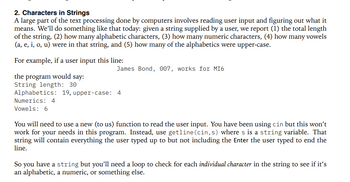
Database System Concepts
7th Edition
ISBN: 9780078022159
Author: Abraham Silberschatz Professor, Henry F. Korth, S. Sudarshan
Publisher: McGraw-Hill Education
expand_more
expand_more
format_list_bulleted
Topic Video
Question

Transcribed Image Text:# Characters in Strings
A large part of the text processing done by computers involves reading user input and figuring out what it means. We’ll do something like that today: given a string supplied by a user, we report (1) the total length of the string, (2) how many alphabetic characters, (3) how many numeric characters, (4) how many vowels (a, e, i, o, u) were in that string, and (5) how many of the alphabetics were upper-case.
For example, if a user inputs this line:
```
James Bond, 007, works for MI6
```
the program would say:
- String length: 30
- Alphabetics: 19, upper-case: 4
- Numerics: 4
- Vowels: 6
You will need to use a new (to us) function to read the user input. You have been using `cin` but this won’t work for your needs in this program. Instead, use `getline(cin,s)` where `s` is a `string` variable. That string will contain everything the user typed up to but not including the Enter the user typed to end the line.
So you have a `string` but you’ll need a loop to check for each *individual character* in the string to see if it’s an alphabetic, a numeric, or something else.
Expert Solution
arrow_forward
Step 1
These question answer is as follows
Trending nowThis is a popular solution!
Step by stepSolved in 4 steps with 3 images

Knowledge Booster
Learn more about
Need a deep-dive on the concept behind this application? Look no further. Learn more about this topic, computer-science and related others by exploring similar questions and additional content below.Similar questions
- Exactly what are strings, if anything?arrow_forwardAt least a paragraph with simlier example Looking at how computers are able to store words in their memory using the ASCII character set. Choose a short phrase with at least 2 words and then convert each character in that phrase to hexadecimal using the ASCII table provided in this module. Make sure that you also convert any spaces and punctuation in your chosen phrase! In your post, tell me what phrase you chose and then write out the hexadecimal representation of that phrase with spaces between each hex number. For example, lets say the phrase I choose is "Hello World". To convert that to hexadecimal, I would bring up the ASCII table and look up each character in my phrase. First I would look up "H" and see that it has the code 48. Then I would look up "e", which has the code 65. Then "l", which becomes 6C. I would continue this way until I have converted the whole phrase to hexadecimal (including the space between the words, which has code 20). The complete encoded phrase ends up…arrow_forwardAll computers store the strings of O's and 1's of binary numbers in the same format. True Falsearrow_forward
arrow_back_ios
arrow_forward_ios
Recommended textbooks for you
 Database System ConceptsComputer ScienceISBN:9780078022159Author:Abraham Silberschatz Professor, Henry F. Korth, S. SudarshanPublisher:McGraw-Hill Education
Database System ConceptsComputer ScienceISBN:9780078022159Author:Abraham Silberschatz Professor, Henry F. Korth, S. SudarshanPublisher:McGraw-Hill Education Starting Out with Python (4th Edition)Computer ScienceISBN:9780134444321Author:Tony GaddisPublisher:PEARSON
Starting Out with Python (4th Edition)Computer ScienceISBN:9780134444321Author:Tony GaddisPublisher:PEARSON Digital Fundamentals (11th Edition)Computer ScienceISBN:9780132737968Author:Thomas L. FloydPublisher:PEARSON
Digital Fundamentals (11th Edition)Computer ScienceISBN:9780132737968Author:Thomas L. FloydPublisher:PEARSON C How to Program (8th Edition)Computer ScienceISBN:9780133976892Author:Paul J. Deitel, Harvey DeitelPublisher:PEARSON
C How to Program (8th Edition)Computer ScienceISBN:9780133976892Author:Paul J. Deitel, Harvey DeitelPublisher:PEARSON Database Systems: Design, Implementation, & Manag...Computer ScienceISBN:9781337627900Author:Carlos Coronel, Steven MorrisPublisher:Cengage Learning
Database Systems: Design, Implementation, & Manag...Computer ScienceISBN:9781337627900Author:Carlos Coronel, Steven MorrisPublisher:Cengage Learning Programmable Logic ControllersComputer ScienceISBN:9780073373843Author:Frank D. PetruzellaPublisher:McGraw-Hill Education
Programmable Logic ControllersComputer ScienceISBN:9780073373843Author:Frank D. PetruzellaPublisher:McGraw-Hill Education

Database System Concepts
Computer Science
ISBN:9780078022159
Author:Abraham Silberschatz Professor, Henry F. Korth, S. Sudarshan
Publisher:McGraw-Hill Education

Starting Out with Python (4th Edition)
Computer Science
ISBN:9780134444321
Author:Tony Gaddis
Publisher:PEARSON

Digital Fundamentals (11th Edition)
Computer Science
ISBN:9780132737968
Author:Thomas L. Floyd
Publisher:PEARSON

C How to Program (8th Edition)
Computer Science
ISBN:9780133976892
Author:Paul J. Deitel, Harvey Deitel
Publisher:PEARSON

Database Systems: Design, Implementation, & Manag...
Computer Science
ISBN:9781337627900
Author:Carlos Coronel, Steven Morris
Publisher:Cengage Learning

Programmable Logic Controllers
Computer Science
ISBN:9780073373843
Author:Frank D. Petruzella
Publisher:McGraw-Hill Education